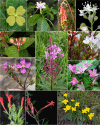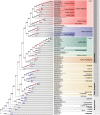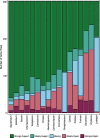A phylogeny of the evening primrose family (Onagraceae) using a target enrichment approach with 303 nuclear loci
- PMID: 37974080
- PMCID: PMC10655384
- DOI: 10.1186/s12862-023-02151-9
A phylogeny of the evening primrose family (Onagraceae) using a target enrichment approach with 303 nuclear loci
Abstract
Background: The evening primrose family (Onagraceae) includes 664 species (803 taxa) with a center of diversity in the Americas, especially western North America. Ongoing research in Onagraceae includes exploring striking variation in floral morphology, scent composition, and breeding system, as well as the role of these traits in driving diversity among plants and their interacting pollinators and herbivores. However, these efforts are limited by the lack of a comprehensive, well-resolved phylogeny. Previous phylogenetic studies based on a few loci strongly support the monophyly of the family and the sister relationship of the two largest tribes but fail to resolve several key relationships.
Results: We used a target enrichment approach to reconstruct the phylogeny of Onagraceae using 303 highly conserved, low-copy nuclear loci. We present a phylogeny for Onagraceae with 169 individuals representing 152 taxa sampled across the family, including extensive sampling within the largest tribe, Onagreae. Deep splits within the family are strongly supported, whereas relationships among closely related genera and species are characterized by extensive conflict among individual gene trees.
Conclusions: This phylogenetic resource will augment current research projects focused throughout the family in genomics, ecology, coevolutionary dynamics, biogeography, and the evolution of characters driving diversification in the family.
Keywords: Evening primrose; HybSeq; Onagraceae; Phylogenetics; Phylogenomics; Plant systematics; Target enrichment.
© 2023. The Author(s).
Conflict of interest statement
The authors declare no competing interests.
Figures





Similar articles
-
Family-level relationships of Onagraceae based on chloroplast rbcL and ndhF data.Am J Bot. 2003 Jan;90(1):107-15. doi: 10.3732/ajb.90.1.107. Am J Bot. 2003. PMID: 21659085
-
Extensive population-level sampling reveals clinal variation in (R)-(-)-linalool produced by the flowers of an endemic evening primrose, Oenothera harringtonii.Phytochemistry. 2022 Aug;200:113185. doi: 10.1016/j.phytochem.2022.113185. Epub 2022 Apr 15. Phytochemistry. 2022. PMID: 35436476
-
Differential gene expression associated with a floral scent polymorphism in the evening primrose Oenothera harringtonii (Onagraceae).BMC Genomics. 2022 Feb 12;23(1):124. doi: 10.1186/s12864-022-08370-6. BMC Genomics. 2022. PMID: 35151274 Free PMC article.
-
Evening Primrose (Oenothera biennis) Biological Activity Dependent on Chemical Composition.Antioxidants (Basel). 2018 Aug 14;7(8):108. doi: 10.3390/antiox7080108. Antioxidants (Basel). 2018. PMID: 30110920 Free PMC article. Review.
-
The potential and outgoing trends in traditional, phytochemical, economical, and ethnopharmacological importance of family Onagraceae: A comprehensive review.J Ethnopharmacol. 2021 Dec 5;281:114450. doi: 10.1016/j.jep.2021.114450. Epub 2021 Jul 24. J Ethnopharmacol. 2021. PMID: 34314807 Review.
Cited by
-
Novel perspectives on plastome evolution in Onagraceae.AoB Plants. 2025 Apr 24;17(3):plaf025. doi: 10.1093/aobpla/plaf025. eCollection 2025 Jun. AoB Plants. 2025. PMID: 40574894 Free PMC article.
References
-
- Wagner WH, Hoch PC, Raven PH. Revised classification of the Onagraceae. Syst Bot Monogr. 2007;83:1–240.
-
- Katinas L, Crisci JV, Wagner WL, Hoch PC. Geographical diversification of tribes Epilobieae, Gongylocarpeae, and Onagreae (Onagraceae) in North America, based on parsimony analysis of endemicity and track compatibility analysis. Ann Mo Bot Gard. 2004;91(1):159–85.
-
- Hoch PC, Raven PH. Boisduvalia, a coma-less Epilobium (Onagraceae). Phytologia. 1992;73:456–9.
-
- Raven PH. A survey of reproductive biology in Onagraceae. NZ J Bot. 1979;17:575–593. doi: 10.1080/0028825X.1979.10432572. - DOI
-
- Berry PE. The systematics and evolution of Fuchsia sect. Fuchsia (Onagraceae). Ann Mo Bot Gard. 1982;69:1–198.
Publication types
MeSH terms
Grants and funding
LinkOut - more resources
Full Text Sources
